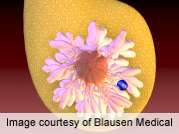(HealthDay)—Breast cancer tumor markers are frequently used for routine surveillance in nonmetastatic breast cancer, and their use has been found to increase the number of diagnostic procedures performed as well as the total cost of care, according to a study published online Oct. 20 in the Journal of Clinical Oncology.
Scott D. Ramsey, M.D., Ph.D., from the Fred Hutchinson Cancer Research Center in Seattle, and colleagues utilized Surveillance, Epidemiology, and End Results-Medicare records to identify patients diagnosed with early-stage breast cancer (2001 and 2007). Billing codes were used to assess tumor marker usage within two years after diagnosis.
The researchers found that, of the 39,650 eligible patients, 16,653 (42 percent) received at least one tumor marker assessment. An average of 5.7 tests were performed over two years, with rates of use per person increasing over time. Age at diagnosis, diagnosis year, stage at diagnosis, race/ethnicity, geographic region, and urban/rural status were all significantly associated with marker use. Rates of advanced imaging were significantly higher in the assessment group, but biopsies were not. After adjusting for other factors, medical costs for patients who received at least one test were approximately 29 percent greater than costs for those who received none.
"A better understanding of factors driving the use of and the potential benefits and harms of surveillance-based tumor marker testing is needed," the authors write.
Several authors disclosed financial ties to the pharmaceutical industry.
More information:
Abstract
Full Text (subscription or payment may be required)
Journal information: Journal of Clinical Oncology
Copyright © 2014 HealthDay. All rights reserved.






















